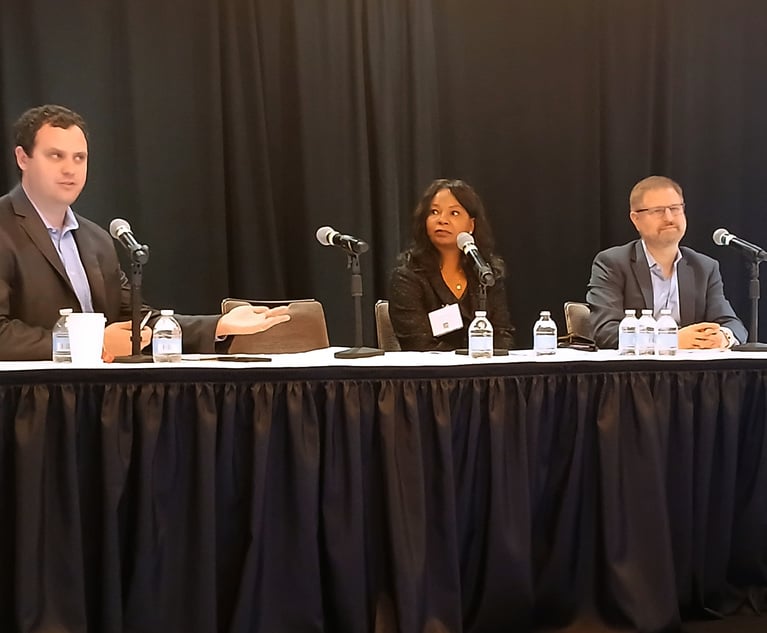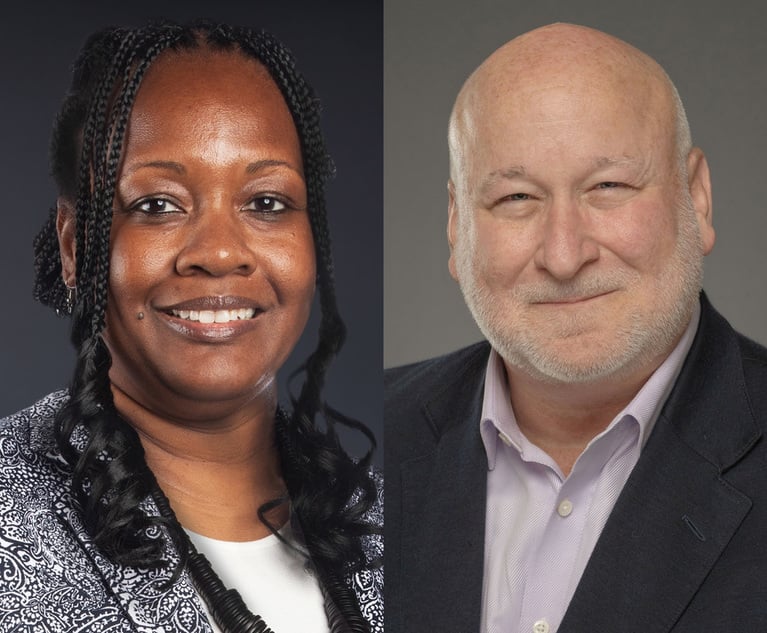Litigation: Proposed amendments to the FRCP prioritize early and active judicial management
Delay itself undermines the goals of Rule 1. Accordingly, certain proposed changes merely shorten time frames already existing in the Rules.
January 30, 2014 at 03:00 AM
6 minute read
The original version of this story was published on Law.com
On May 8, 2013, the Advisory Committee on Civil Rules presented recommended changes to the Federal Rules of Civil Procedure to the Standing Committee on Rules of Practice and Procedure. One of the themes that was carried forward from the 2010 Duke Conference and accordingly was stressed during the Advisory Committee's deliberations is the need for increased early and active judicial management. As discussed below, the Committee proposed changes to three rules that have the aim of furthering that goal.
As the Advisory Committee's report succinctly notes, “time is money.” The early stages of litigation take too long, resulting in greater expense. Delay itself undermines the goals of Rule 1. Accordingly, certain proposed changes merely shorten time frames already existing in the Rules. Other proposed changes support increased judicial management in a more qualitative, as opposed to quantitative, way.
Rule 4(m): Rule 4(m) would be revised to shorten the time to serve the summons and complaint from 120 days to 60 days, except in certain circumstances involving condemnation proceedings. The existing rule had often been criticized on the basis that four months to serve the summons and complaint is too long. Some commenters, notably the Department of Justice (DOJ), objected that there are often sound reasons, such as the DOJ's own organizational complexity, that require substantial time to get a summons and complaint served. Existing language in Rule 4(m) still allows the court to permit a longer time to serve the summons and complaint if the plaintiff shows good cause for the failure to serve within the allowed time.
Rule 16(b)(2): Time for scheduling order: As it now reads, Rule 16(b)(2) requires the judge to issue the scheduling order within the earlier of 120 days after any defendant has been served or 90 days after any defendant has appeared. Some drafts cut these times in half, but the recommended amendment reduces the time to 90 days after any defendant has been served or 60 days after any defendant has appeared. Arguments were raised that lawyers need sufficient time at the beginning of a case to think about the claims and defenses and consider a settlement, and that the times should not be reduced at all. In support of a lesser reduction in time, some voiced a concern that parties cannot properly prepare for a scheduling conference in the more drastically reduced time period. A new provision allows the court to extend the time on a finding of good cause.
Rule 16(b): Actual conference: The existing rule authorizes the issuance of a scheduling order after receiving the parties' Rule 26(f) report or after consulting “at a scheduling conference by telephone, mail, or other means.” The proposed amendment would strike the phrase “by telephone, mail, or other means.” Reflecting the consensus that a conference by mail does not get the job done, this means that a live conference must occur — it may be in person, via telephone or video, but it must be live and may not be in writing.
Rules 16(b)(3), 26(f): Additional subjects: Three additional subjects are proposed for the Rule 16(b)(3) list of permitted contents of a scheduling order; of these, two are also proposed for the list of topics to be addressed in a Rule 26(f) discovery plan. The proposed amendments would allow a scheduling order and discovery plan to provide for the preservation of electronically stored information and to include agreements reached under Federal Rule of Evidence 502 (relating to inadvertently produced privileged documents). The Sub-Committee believed that adding these provisions would remind litigants that these are topics that should be addressed early. The Evidence Rules Committee is concerned that FRE 502 is underutilized, and an express reference to it might promote greater use.
The third item added to the list of permitted contents to a scheduling order is a new provision, Rule 16(b)(3)(v), allowing a scheduling order to “direct that before moving for an order relating to discovery the movant must request a conference with the court.” Many courts, although less than half, now include such a requirement in their local court rules. The required conference often resolves the issue without the need for motion, briefing, and order and thus is seen by many judges as effective in reducing cost and delay. The Sub-Committee considered making the conference an outright requirement, but decided instead to allow it to be permissive, leaving the matter to individual courts to incorporate into scheduling orders, or not.
Rule 26(d)(1): Early Rule 34 requests: Proposed new Rule 26(d)(2) provides:
Early Rule 34 Requests.
(A) Time to Deliver. More than 21 days after the summons and complaint are served on any party, a request under Rule 34 may be delivered: (i) to that party by any other party, and (ii) by that party to any plaintiff or to any other party that has been served.
(B) When Considered Served. The request is considered as served at the first Rule 26(f) conference.
The rationale for this provision is to allow the Rule 26(f) conference to be used to discuss and consider actual discovery requests. Note that Rule 34 requests to produce are the only type of discovery that may be served during this time, as opposed to deposition notices or interrogatories. A companion provision, a proposed amendment to Rule 34, would set the time to respond to these early requests to within 30 days after the first Rule 26(f) conference.
Discussion centered on whether any litigant would use this provision and risk exposure of its discovery strategy voluntarily before it must do so. Some participants said they would do so to facilitate the Rule 26(f) conference; others expressed doubt that parties would do this. The focus on Rule 34 requests also constitutes a recognition that document discovery generally imposes the heaviest discovery burdens and costs.
The next installment of this series will discuss proposed amendments that address cooperation in discovery.
This content has been archived. It is available through our partners, LexisNexis® and Bloomberg Law.
To view this content, please continue to their sites.
Not a Lexis Subscriber?
Subscribe Now
Not a Bloomberg Law Subscriber?
Subscribe Now
NOT FOR REPRINT
© 2025 ALM Global, LLC, All Rights Reserved. Request academic re-use from www.copyright.com. All other uses, submit a request to [email protected]. For more information visit Asset & Logo Licensing.
You Might Like
View All
Lawyers Drowning in Cases Are Embracing AI Fastest—and Say It's Yielding Better Outcomes for Clients

GC Conference Takeaways: Picking AI Vendors 'a Bit of a Crap Shoot,' Beware of Internal Investigation 'Scope Creep'
8 minute read
Why ACLU's New Legal Director Says It's a 'Good Time to Take the Reins'
Trending Stories
Who Got The Work
Michael G. Bongiorno, Andrew Scott Dulberg and Elizabeth E. Driscoll from Wilmer Cutler Pickering Hale and Dorr have stepped in to represent Symbotic Inc., an A.I.-enabled technology platform that focuses on increasing supply chain efficiency, and other defendants in a pending shareholder derivative lawsuit. The case, filed Oct. 2 in Massachusetts District Court by the Brown Law Firm on behalf of Stephen Austen, accuses certain officers and directors of misleading investors in regard to Symbotic's potential for margin growth by failing to disclose that the company was not equipped to timely deploy its systems or manage expenses through project delays. The case, assigned to U.S. District Judge Nathaniel M. Gorton, is 1:24-cv-12522, Austen v. Cohen et al.
Who Got The Work
Edmund Polubinski and Marie Killmond of Davis Polk & Wardwell have entered appearances for data platform software development company MongoDB and other defendants in a pending shareholder derivative lawsuit. The action, filed Oct. 7 in New York Southern District Court by the Brown Law Firm, accuses the company's directors and/or officers of falsely expressing confidence in the company’s restructuring of its sales incentive plan and downplaying the severity of decreases in its upfront commitments. The case is 1:24-cv-07594, Roy v. Ittycheria et al.
Who Got The Work
Amy O. Bruchs and Kurt F. Ellison of Michael Best & Friedrich have entered appearances for Epic Systems Corp. in a pending employment discrimination lawsuit. The suit was filed Sept. 7 in Wisconsin Western District Court by Levine Eisberner LLC and Siri & Glimstad on behalf of a project manager who claims that he was wrongfully terminated after applying for a religious exemption to the defendant's COVID-19 vaccine mandate. The case, assigned to U.S. Magistrate Judge Anita Marie Boor, is 3:24-cv-00630, Secker, Nathan v. Epic Systems Corporation.
Who Got The Work
David X. Sullivan, Thomas J. Finn and Gregory A. Hall from McCarter & English have entered appearances for Sunrun Installation Services in a pending civil rights lawsuit. The complaint was filed Sept. 4 in Connecticut District Court by attorney Robert M. Berke on behalf of former employee George Edward Steins, who was arrested and charged with employing an unregistered home improvement salesperson. The complaint alleges that had Sunrun informed the Connecticut Department of Consumer Protection that the plaintiff's employment had ended in 2017 and that he no longer held Sunrun's home improvement contractor license, he would not have been hit with charges, which were dismissed in May 2024. The case, assigned to U.S. District Judge Jeffrey A. Meyer, is 3:24-cv-01423, Steins v. Sunrun, Inc. et al.
Who Got The Work
Greenberg Traurig shareholder Joshua L. Raskin has entered an appearance for boohoo.com UK Ltd. in a pending patent infringement lawsuit. The suit, filed Sept. 3 in Texas Eastern District Court by Rozier Hardt McDonough on behalf of Alto Dynamics, asserts five patents related to an online shopping platform. The case, assigned to U.S. District Judge Rodney Gilstrap, is 2:24-cv-00719, Alto Dynamics, LLC v. boohoo.com UK Limited.
Featured Firms
Law Offices of Gary Martin Hays & Associates, P.C.
(470) 294-1674
Law Offices of Mark E. Salomone
(857) 444-6468
Smith & Hassler
(713) 739-1250







